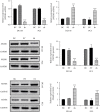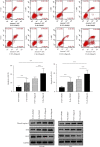Expression of MUS81 Mediates the Sensitivity of Castration-Resistant Prostate Cancer to Olaparib
- PMID: 35910852
- PMCID: PMC9334051
- DOI: 10.1155/2022/4065580
Expression of MUS81 Mediates the Sensitivity of Castration-Resistant Prostate Cancer to Olaparib
Abstract
This project attempts to clarify the expression of MUS81 in castration-resistant prostate cancer (CRPC) and the effect on drug sensitivity to Olaparib. We collected clinical surgical samples of patients who were suffering from benign prostatic hyperplasia (BPH), common prostate cancer (PCa), and castration-resistant prostate cancer (CRPC) and detected the expression of MUS81 in healthy prostate epithelial cells, PCa cells, and androgen-independent PCa cells. We subsequently performed CCK-8 assays, flow cytometry, and Transwell invasion and migration assay to determine the proliferation, apoptosis, invasion, and metastasis abilities of transfected CRPC cells as well as drug toxicity of Olaparib to CRPC cells. The expression of MUS81 indicated marked upregulation in PCa and CRPC tissues, compared with the level of MUS81 in BPH tissues. MUS81 silencing inhibited the proliferation of CRPC cells and promoted their sensitivity to Olaparib. MUS81 silencing in CRPC cells remarkably accelerated cell apoptosis and greatly inhibited cell invasion and metastasis after Olaparib administration. MUS81 silencing in CRPC cells has significantly enhanced the sensitivity of cells to Olaparib, which provides evidence for the prediction of Olaparib resistance in CRPC cells by the MUS81 gene and is expected to become a promising gene target in CRPC therapy.
Copyright © 2022 Lifeng Gong et al.
Conflict of interest statement
The authors declare that they have no competing interest.
Figures







Similar articles
-
Targeting NPRL2 to enhance the efficacy of Olaparib in castration-resistant prostate cancer.Biochem Biophys Res Commun. 2019 Jan 8;508(2):620-625. doi: 10.1016/j.bbrc.2018.11.062. Epub 2018 Dec 3. Biochem Biophys Res Commun. 2019. PMID: 30522863
-
Inhibition of MUS81 improves the chemical sensitivity of olaparib by regulating MCM2 in epithelial ovarian cancer.Oncol Rep. 2018 Apr;39(4):1747-1756. doi: 10.3892/or.2018.6229. Epub 2018 Jan 22. Oncol Rep. 2018. PMID: 29393493
-
Upregulation of miR-3195, miR-3687 and miR-4417 is associated with castration-resistant prostate cancer.World J Urol. 2021 Oct;39(10):3789-3797. doi: 10.1007/s00345-021-03723-4. Epub 2021 May 14. World J Urol. 2021. PMID: 33990872 Free PMC article.
-
A Novel Use of Olaparib for the Treatment of Metastatic Castration-Recurrent Prostate Cancer.Pharmacotherapy. 2017 Nov;37(11):1406-1414. doi: 10.1002/phar.2027. Pharmacotherapy. 2017. PMID: 28895177 Review.
-
Androgen receptors in hormone-dependent and castration-resistant prostate cancer.Pharmacol Ther. 2013 Dec;140(3):223-38. doi: 10.1016/j.pharmthera.2013.07.003. Epub 2013 Jul 13. Pharmacol Ther. 2013. PMID: 23859952 Review.
Cited by
-
PARP Inhibitors and Proteins Interacting with SLX4.Cancers (Basel). 2023 Feb 3;15(3):997. doi: 10.3390/cancers15030997. Cancers (Basel). 2023. PMID: 36765954 Free PMC article. Review.
References
-
- Ye D., Zhu Y. Epidemiology of prostate cancer in China: an overview and clinical implication. Zhonghua Wai Ke Za Zhi . 2015;53(4):249–252. - PubMed
MeSH terms
Substances
LinkOut - more resources
Full Text Sources
Medical

